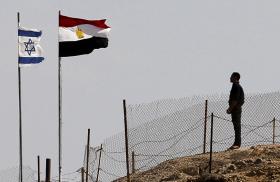
- Policy Analysis
- PolicyWatch 3449
Continued Houthi Strikes Threaten Saudi Oil and the Global Economic Recovery

Saudi Arabia used what Congress might consider “offensive weapons” to successfully defend major oil terminals, but a much more devastating attack is inevitable if Houthi missile and drone attacks persist.
On March 7, a drone struck the world’s largest oil loading facility at Ras Tanura, Saudi Arabia, driving oil prices up to more than $70 per barrel for the first time since the COVID-19 pandemic depressed the global economy. Houthi rebels in Yemen claimed the attack, specifying that they had launched ten long-range drones and one ballistic missile against eastern Saudi Arabia, plus four short-range drones and seven precision rockets against military targets in the southwest.
On one hand, the kingdom showed that it could mount an effective defense against such strikes under certain conditions, credibly claiming to have intercepted almost all of the eleven long-range attacks on the eastern oil hub. U.S. officials should take a close look at how the Saudis parried attacks on civilian infrastructure with American-supplied F-15 jets and AIM-9 Sidewinder missiles—systems that many within Congress view as “offensive weapons” subject to ongoing controversy and potential restrictions.
On the other hand, the attack is a sobering wakeup call and should be viewed for what it is—an attempt to repeat the egregious September 2019 attack on the massive Abqaiq oil processing site. If the Ras Tanura strike had succeeded, it might have damaged global oil exports as much as that similar operation.
Anatomy of the Attack
The March 7 incidents involved four Houthi strike systems, all of which were provided in part or in full by Iran:
- Ten Sammad-3 drones. The proven 900-mile range of this system is sufficient to reach the eastern shores of several Gulf states from Yemen. Only one of these drones is confirmed to have hit its target on March 7, and its small forty-pound warhead did minimal damage to Ras Tanura’s mammoth twenty-square-mile oil storage facilities. In all, the Saudis credibly claimed to have shot down ten drones, and several of them were Sammad-3s—as shown in Riyadh’s video evidence of two such interceptions by U.S.-supplied F-15s and missiles. Other interceptions may have been achieved using U.S.-supplied Patriot or Hawk surface-to-air missiles or French Shahine missiles.
- One Zolfaqar ballistic missile. When the drone attack failed, the Houthis tried to strike Ras Tanura with a new extended-range variant of the Burkan-2H missile (a system that the UN Panel of Experts on Yemen previously concluded is a modified Iranian Qiam missile). The strike was undertaken at a distance of around 800-900 miles, exceeding the range of any known Houthi ballistic missile launch (previous Burkan-2H strikes reached 650 miles or less). The Zolfaqar landed just 400 yards from Saudi Aramco housing units where foreign expatriate workers make up the majority of residents.
- Four Qasef-2K drones. The Houthis often try to overload Saudi air defenses with simultaneous shorter-range attacks on targets close to Yemen. On March 7, four Qasef-2K drones (copies of Iran’s Ababil series) were used to strike Saudi air force units at King Khalid Air Base in Khamis Mushait. At least one of them was shot down by an F-15, and others may have been intercepted using Patriot or Hawk missiles.
- Seven Badr precision rockets. The Houthis claimed to hit targets near Yemen with this long-range tactical system, which can strike with great accuracy out to ninety-five miles. Specifically, they were launched at military areas of Abha’s civilian airport and other targets in Jizan and Asir provinces.
The above salvos were just one round in a rolling series of attacks. On February 28, the Houthis claimed to target Riyadh with a Zolfaqar (intercepted by a Patriot) and nine Sammad-3s, while also launching six Qasef-2Ks against Khamis Mushait and Abha. On March 3, they fired a Quds-2 cruise missile at oil tanks in Jeddah. And on March 9, they fired two Burkan-2 missiles at oil facilities in Yanbu (both apparently intercepted by Patriots).
Policy Implications
Given their bombardment of Saudi Arabia and their ground offensive to seize Yemen’s largest energy hub at Marib, the Houthis appear determined to escalate their way to either all-out victory or a better position at the negotiating table. This strategy could galvanize Riyadh to take face-saving measures, including more-strenuous military efforts, further strikes in Yemen (e.g., Saudi forces hit drone and missile construction facilities in Sanaa on March 8), and a visible hesitance to play a constructive role in U.S.-led peace efforts.
Moreover, it is also only a matter of time before Houthi strikes result in a mass-casualty event or a massive oil spill or fire. For example, when rockets hit Abha airport on February 11, they set fire to a civilian airliner, luckily without loss of life. Likewise, Saudi military retaliation for such incidents could easily cause major loss of civilian life. The Houthis are also risking a fatal blow to U.S. peace efforts. The only surefire way to avoid these potential disasters is convincing the Houthis to stop their missile, drone, and rocket attacks.
On March 2, the United States sanctioned Ahmad Ali Ahsan al-Hamzi, whom the Biden administration identified as the Iranian-trained commander of the Houthi missile and drone forces, accusing him of “heinous attacks damaging civilian infrastructure in Yemen and Saudi Arabia.” Other, more senior Houthi leaders should likewise be sanctioned if large-scale strikes continue. Executive Order 13611, which Hamzi was designated under for “threatening the stability” of Yemen, is reversible—it can be applied to any Houthi leader at will and then removed when the negative behavior in question ceases.
U.S. authorities should also draw a number of political-military lessons from the evolving Houthi missile and drone campaign:
- Offensive weapons, defensive purposes. Few weapons are purely offensive, so a blanket U.S. ban on selling “offensive weapons” to Saudi Arabia is inherently problematic. In the eyes of some congressmen, both the F-15s and the Sidewinder missiles used to intercept Houthi drones on March 7 are offensive weapons that the kingdom should not receive, upgrade, or maintain with U.S. help. Accordingly, legislators should conduct a thoughtful review of how the Saudis actually use American weapons and how Washington can monitor this end use, rather than focusing on broad category bans.
- The value of defensive intelligence. Saudi Arabia was able to mount an effective defense on March 7 in part because it spotted the attack at an early stage. This intelligence came from U.S.-supplied platforms (e.g., airborne early warning aircraft) and direct provision of warning intelligence gathered by U.S.-operated systems. This defensive assistance is valuable and should continue.
- Focus on maritime intercept operations. The Houthis are increasing their missile salvos against Saudi Arabia because they have no fear of shortages. As the Biden administration and the UN have pointed out, the rebels can draw on covert shipments of Iranian-supplied drone engines, ballistic missile motors, and electronics. The United States needs to work with international partners to tighten the intelligence-driven arms embargo on Yemen, with a focus on not only Houthi-held ports, but also other ports in Yemen and Oman through which missile, rocket, and drone components flow. These include dual-use materials such as fiber glass, a component in drone and missile bodies. All aircraft that land in Houthi-held areas should be inspected, since even small aircraft can carry large stocks of specialized components.
- Target the network. Washington should consider how it might shape selective Saudi strikes on drone and missile factories inside Yemen—a U.S. tactic used regularly against militias in Iraq and Syria. On February 26, for example, U.S. forces responded to a previous Iraqi militia rocket attack against coalition military facilities in Erbil by conducting what the Biden administration called a “defensive” airstrike on militia weapons facilities in Syria. Of course, expanding maritime interception of smuggled arms is ideal, since the risk of collateral damage in such operations is almost nil. In select cases, however, the United States should also help Riyadh conduct cleaner defensive strikes further “upstream,” before missiles and drones are built, deployed, or launched. Such assistance could help reduce the destructiveness of the Yemen conflict while still lessening the threat of strikes inside Saudi Arabia.
- Importance of collaboration on next-generation missile and drone defenses. The recent string of attacks underlines the fact that counter-missile, rocket, and drone defenses are now the paramount military need in the Middle East. The Saudis may have evolved from firing a $3 million Patriot at every drone, but they are still firing $400,000 air-to-air missiles at drones that cost $20,000 or less. As for ballistic missiles, Washington should help Israel provide the Saudis with its David’s Sling defense system, which is more cost-effective than the Patriot ($1 million per shot). In parallel, U.S. officials should press ahead with alacrity to forge a missile defense “Manhattan Project” that can deliver effective and affordable directed-energy defenses (i.e., high-energy laser and high-power microwave) and hypervelocity artillery rounds to Israeli, Gulf, and Asian partners in this decade.
Michael Knights is the Bernstein Fellow with The Washington Institute.



